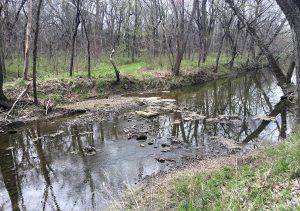Potosi, Kansas, once located on Mine Creek, about two miles east of Pleasanton in Linn County, is now an extinct town.
The settlement started in 1856 when a town company comprised of all pro-slavery men laid out the townsite on 320 acres. First called Hillsborough, it gained a post office on September 17, 1857, with John W. Garrett as Postmaster. J.E. Hill and Mr. Garrett built a store, and O.H. Sykes also built a sawmill.
At one time, the town had six houses and about 30 inhabitants. By 1859, the area was under the control of Free-State men, and the town’s name was changed to Potosi in November. It took its name from the mining activity that had once taken place there. In the early 19th century, explorers found abandoned mining sites along a creek south of the Marais des Cygnes River. The background of these early miners remains a mystery, but it inspired early residents of the region to name this waterway “Mine Creek.” The town and township were named after Potosi, Mexico, a famous silver-producing region. The post office name was officially changed to Potosi on November 8, 1859.
Potosi struggled from the beginning with the Kansas-Missouri Border War in the 1850s and the Civil War of the 1860s. In addition to the political struggles, the region also experienced a major drought from 1859 to 1861, during which hundreds left the area.
After the Civil War, many began moving into the region again, but when Pleasanton was established, it spelled doom for tiny Potosi. Situated on the Kansas City, Fort Scott & Gulf Railroad, Pleasanton grew quickly, and Potosi was abandoned. Its post office closed on August 10, 1869.
©Kathy Alexander/Legends of Kansas, updated June 2024.
Source:
Cutler, William G.; Kansas: History of the State of Kansas, 1883.

